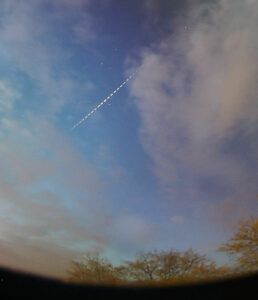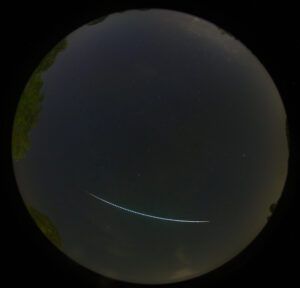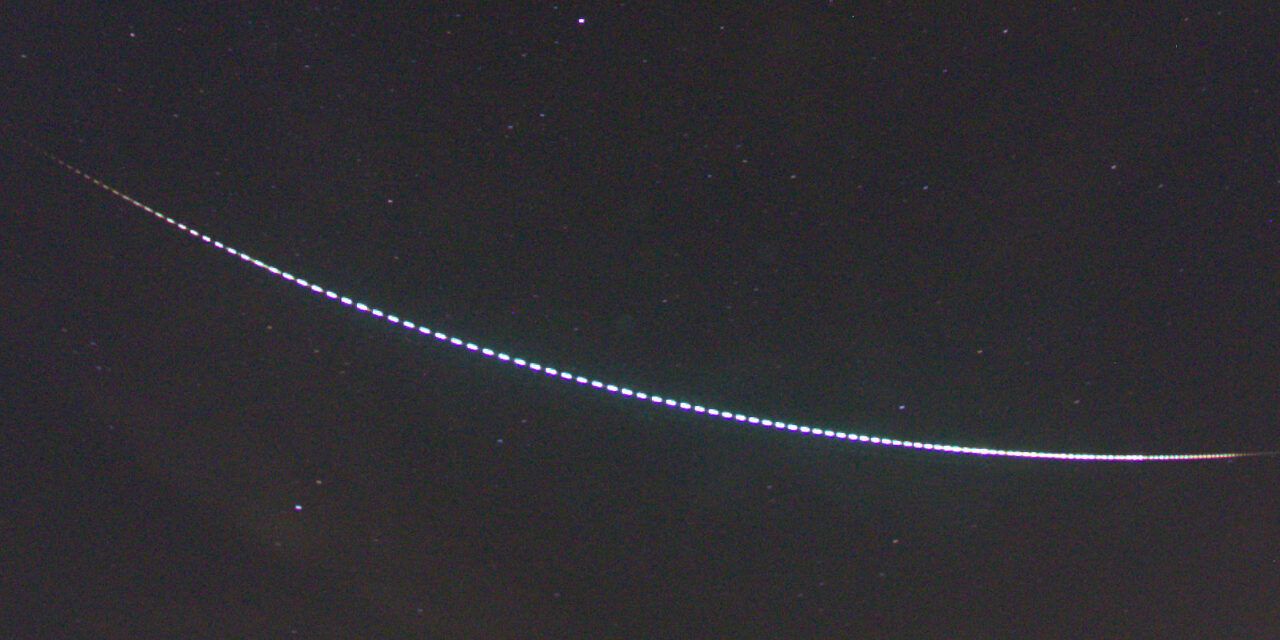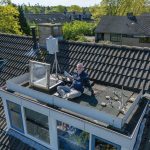In June, after a very cloudy and rainy spring, visual observations could be made more often again. Unfortunately, regular hay fever attacks also prevented doing visual meteor observation during a number of clear nights in June. This report describes also some earlier sessions from 2023. Table 1 provides an overview of all observations until July 1st, 2023.
|
Date |
Teff (min) |
Total t.eff. |
Lm. |
SQMmax |
Ndate |
Nyear |
Night nr. |
Fireball(s) |
Location |
|
21/22-01 |
105 |
1.75 |
6.2 |
20.28 |
15 |
15 |
1268 |
~ |
ERM |
|
25/26-02 |
180 |
4.75 |
6.4 |
20.45 |
21 |
36 |
1269 |
~ |
ERM |
|
26/27-02 |
135 |
7.00 |
6.3 |
20.38 |
17 |
53 |
1270 |
~ |
ERM |
|
18/19-04 |
140 |
9.33 |
6.2 |
20.23 |
13 |
66 |
1271 |
~ |
ERM |
|
09/10-06 |
120 |
11.33 |
6.1 |
20.12 |
14 |
80 |
1272 |
~ |
ERM |
|
10/11-06 |
120 |
13.33 |
6.2 |
20.14 |
12 |
92 |
1273 |
~ |
ERM |
|
14/15-06 |
125 |
15.42 |
6.3 |
20.15 |
20 |
112 |
1274 |
~ |
ERM |
|
16/17-06 |
123 |
17.47 |
6.3 |
20.15 |
16 |
128 |
1275 |
-3 SPO |
ERM |
Table 1: overview of the author’s observations
As written, the period January-May 2023 was characterized by many cloudy days and also a lot of rain. The night 21/22 January was partly clear and the observations were also ended by clouds. Two sporadic magnitude 0 and +1 meteors were the most beautiful ones. Observations were done from the flat roof of the dormer (my so called “meteor platform”), the temperature dropped to -4 degrees Celsius. Two nights with clear skies followed at the end of February: February 25/26 and February 26/27. During both nights observations were done from the Groevenbeekse Heide (a heath). Very low temperatures were recorded at ground level: on February 26 -8 degrees Celsius and on February 27 even -12 degrees Celsius! Due to the low meteor season only a few meteors, I counted between 5 and 9 meteors an hour. No bright meteors in the first night, the second yielded a few more meteors of +1 and -1.
In April the Lyrids made their appearance. Also this month many cloudy nights. Only 18/19 and 21/22 April were partly clear. The night April 18/19 observations were done during two hours from the heath under a very hazy sky. Limiting magnitude maximum 6.2 and very low meteor activity. Only 2 Lyrids, 1 ANT and 9 SPO. April 21/22 it cleared unexpectedly around 23 UT, I just came home from a concert and was too tired to do anything. It also seemed to be cloudy again. That indeed happened, but soon after that it cleared up again and it remained clear until the morning twilight. The all sky camera captured 2 small Lyrid fireballs. The maximum night April 22/23 had also a “clear” sky, but due to fog and very hazy conditions the limiting magnitude got no better than 4.0. So no visual observations, but again the all sky camera captured a small Lyrid fireball.
Midsummer nights in June 2023.

Figure 1. The fireball of May 7, 2023 photographed through the clouds by all sky camera EN908.
Camera: Canon 6D, Sigma 8 mm F 4.0 with Lyquid Crystal Shutter set at 16 br/s.
In June, in the Netherlands, it got no longer astronomical dark. The sun does not get lower than 18 degrees below the horizon, this result in a twilight starry sky in a northerly direction, while the sky background in other directions remains somewhat lighter than in other months. Each night there is a period of about two hours when de limiting magnitude is increasing from lm 5.8 to 6.2 sometimes 6.3 at 23:30 UT, and then slowly decreasing again to 5.8 at the end of the session. Despite the lesser viewing conditions, there is still quite a bit to see. And the continue twilight in northern direction, the possible Noctilucent clouds (NLC), the sounds of birds, frogs and foxesadds something special to the night sky. And there are nice numbers of meteors to see when the transparency is good. This year in June I had another two weeks of vacation and finally a period of warm and stable summer weather started. No vacation in northern France this year, we stayed at home for several reasons. Lots of clear nights, but some of these nights I could not observe due to very hazy conditions or severe hay fever attacks.
In total I was able to do four short sessions. All observations were done at the Groevenbeekse Heide. During all sessions frogs could be heard on the heath, I had never heard that before from that location! A number of times I was also visited by a large owl.
June 9/10, 2023
Very hazy conditions this night. At the zenith, the limiting magnitude still reached 6.2, but the transparency quickly decreases towards the horizon. For example, of the constellation Scorpio only the stars Antares and β and δ were (barely) visible. The first hour only 5 and the second hour still 9 meteors. An Antihelion meteor of +2 was the highlight. Of course many dozens of satellites were visible again, but I didn’t get the impression that it was much more than in previous years. More often visible are those short bright flashes of light caused by rapidly rotating or spinning satellites. With the disappearance of the Iridium satellites, the associated very bright “Iridium” flares are disappeared. No NLCs visible this night.
June 10/11, 2023
This night the conditions were slightly better. The Milky Way was a little easier to see and more stars could be seen in the Scorpio region. However, this had no positive effect on the meteors, with hourly counts of only 6 meteors in both hours, one of which was a +3 Antihelion. No meteors from the gamma Delphinid radiant were seen. Again no NLCs this night.
June 14/15, 2023
Finally a beautiful night. Great transparency, a beautiful Milky Way visible despite the gray nights. The limiting magnitude briefly touched 6.3 around 23:40 UT. In total 8 and 12 meteors were seen respectively, these are good numbers for a June night! A possible June Lyride of +1 was seen moving from Hercules to Corona Borealis. Three Antihelions (+3, +4, +4) were counted. A beautiful +4 APEX meteor moved along a long trajectory across the sky. No NLCs this night.
June 15/16, 2023
Again a nice clear night, but just a little less than the previous night. Again the limiting magnitude briefly touched 6.3. With hourly counts of 7 and 9 also nice activity. This night I saw a striking number of bright meteors. First a beautiful short, orange and fast -2 sporadic meteor appeared above the star β Scorpio. At 23:44 UT a fast +1 sporadic meteor in Cygnus and at 23:48 UT a magnitude 0 sporadic meteor in Cassiopeia. The most beautiful meteor was at 00:27 UT, just before the end of the session: a fast yellow sporadic meteor of -2 with a short flash of -3 again in Cygnus leaving a persistent train of 3 seconds.
During the last minutes of this session, sharply defined fog banks formed over the heath. What a beautiful sight! Because of the clean and dry air, it was a relatively cold night. Around 00:22 UT the temperature was +2 degrees Celsius at ground level.
Summarizing
The first half of 2023 was not a very good one for visual meteor observations. In total, only 128 meteors were counted. My all sky camera EN908 recorded a number of nice fireballs during this period. On May 7, 2023 at 20:27:05 UT, a bright fireball was obtained through many clouds. This turned out to be simultaneous with all sky camera at Dwingeloo (operator: Felix Bettonvil) and Oostkapelle (operator Klaas Jobse). The brilliant fireball of May 27, 2023 01:09:08 UT was also beautifully captured from Ermelo, including some fragmentation. This fireball was captured by 11 other stations of the BeNeLux European Network [1]. The results of these fireballs can be found in the newest issue of Radiant 2023-2 [2] and on the website of the Dutch Meteor Society [3].

Figure 2. The big fireball of May 27, 2023: 10 seconds of fireworks. According to many eye witness accounts the fireball showed fragmentation during a large part of the traject. Camera: Canon 6D, Sigma 8 mm F 4.0 with Lyquid Crystal Shutter set at 16 br/s.
 Figure 3. Fragmentation is also clearly visible of the image! A sonic boom was heard by an observer from the Bussloo Public Observatory.
Figure 3. Fragmentation is also clearly visible of the image! A sonic boom was heard by an observer from the Bussloo Public Observatory.
1] https://www.dutch-meteor-society.nl/2023/05/27/tatsu-3993/
[2] https://www.dutch-meteor-society.nl/2023/07/01/radiant-2023-2/






